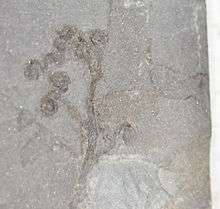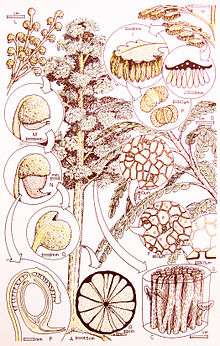Umkomasia macleanii
| Umkomasia macleanii Temporal range: Triassic | |
|---|---|
 | |
| Umkomasia macleanii fossil ovulate structure, Late Triassic, Molteno Formation, Umkomaas, South Africa. | |
| Scientific classification | |
| Kingdom: | Plantae |
| Division: | Pteridospermatophyta |
| Order: | Peltaspermales |
| Family: | Corystospermaceae |
| Genus: | Umkomasia Thomas (1933)[1] |
| Species: | U. macleanii |
| Binomial name | |
| Umkomasia macleanii Thomas | |
Umkomasia macleanii is an ovulate structure of a seed fern (Pteridospermatophyta and the nominate genus of Family Umkomasiaceae. It was first described by Hamshaw Thomas [1] from the Umkomaas locality of South Africa.

Umkomasia macleani reconstruction of whole plant including leaves (Dicroidium odontopteroides, pollen organs (Pteruchus africanus based largely on material from the Umkomaas locality of South Africa[2]
Description
The ovulate structures of Umkomasia macleanii differ from other species of Umkomasia in small size, and limited geographic distribution.
Whole plant reconstructions
Umkomasia macleanii may have been produced by the same plant as Pteruchus africanus (pollen organs) and Dicroidium odontopteroides (leaves), based on cuticular similarities between these leaves and reproductive structures at the Umkomaas locality of South Africa.[1]
References
- 1 2 3 Thomas, H.H. (1933). "On some pteridospermous plants from the Mesozoic rocks of South Africa". Philosophical Transactions of the Royal Society Series B. 222: 193–265. doi:10.1098/rstb.1932.0016.
- ↑ Retallack, G.J. & Dilcher, D.L (1988). "Reconstructions of selected seed ferns.". Annals of the Missouri Botanical Garden. 75: 1010–1057. doi:10.2307/2399379.
This article is issued from Wikipedia - version of the 8/6/2016. The text is available under the Creative Commons Attribution/Share Alike but additional terms may apply for the media files.